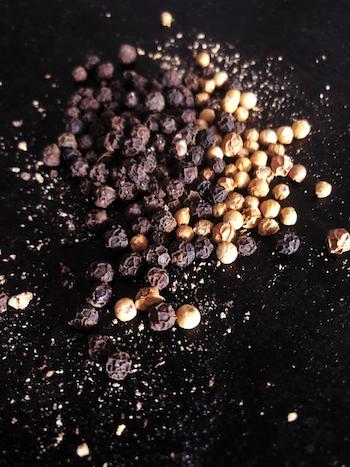As we slip into December, the cold winter wind begins to rattle everything that stood silent in our garden all through the long hot summer. The quiet of the morning kitchen is what I love to wake up to.
I slowly potter around wiping down kitchen platforms and rinsing a few bits and bowls from the previous night. I grind some fresh coffee beans, put on the kettle, make my morning cuppa, and as I take that first sip of coffee everything about the weather that winter brings seems to make that cup of coffee somehow richer, darker, warmer, both in aroma and flavour. Winter is a time when the familiar fragrances seem to quicken my heartbeat, send my tummy into overdrive, craving all things necessary, unnecessary, and comforting.
As I get hungrier through the day during this season I reach out for rich soups, roasted corn, hot chocolate. Dream of Christmas goodies, homely stews, spiced teas, dark coffees, and gooey cheese. I eat more ghee, butter, and, sesame, pumpkin, and add spices to my food like nutmeg, chili, cloves, cinnamon, and pepper.
Like winter brings with her warmth and richness to the season, pepper brings in both depth and spice in most of the food we cook all through the year. Walk into any kitchen, and pepper is what you are sure to find in some quantity, in homes, restaurants, and cafes around the world. It is after all the king of spices, the third most used ingredient, and the only spice present in most recipes the world over.
Used in both savoury and sweet. Pepper is often taken for granted much like salt or water but it was once used as money to pay taxes, rent, and to pay off debts. It is the oldest, most traded, and longest cultivated spice. Stuffed in the noses of Pharos, carried by Buddhist monks as medicine, and used to pay off ransoms, pepper has always been regarded as a spice of great value.
Black, white, green, or pink?
Pepper is a fruit. The berry of the Piper nigrum grows in large tapering bunches. Although black pepper is found in most tropical regions and native to Kerala, India, the ones found in Pondicherry and Kampot pepper in Cambodia is considered the better varieties.
Most of us have come across black pepper in some form whether roughly crushed, powdered, or whole. So what are the other varieties of pepper?
White pepper is just black pepper without the outer skin. Here ripe red berries are soaked in water for a week to soften the skin that is removed and then dried leaving us with black pepper.
Green pepper is immature pepper picked freshly from the vine. It is mostly brined and also added to a lot of dishes in Vietnam and Thailand.
Pink pepper is not true pepper but the dried berry of a shrub known as the Peruvian pepper tree, a different plant altogether. And if you ever do spot red pepper it is the fully ripe version of black pepper.


 Fr. Warner D'Souza is a Catholic priest of the Archdiocese of Bombay. He has served in the parishes of St Michael's (Mahim), St Paul's (Dadar East), Our Lady of Mount Carmel, (Bandra), a ten year stint as priest-in-charge at St Jude Church (Malad East) and at present is the Parish Priest at St Stephen's Church (Cumballa Hill). He is also the Director of the Archdiocesan Heritage Museum and is the co-ordinator of the Committee for the Promotion and Preservation of the Artistic and Historic Patrimony of the Church.
Fr. Warner D'Souza is a Catholic priest of the Archdiocese of Bombay. He has served in the parishes of St Michael's (Mahim), St Paul's (Dadar East), Our Lady of Mount Carmel, (Bandra), a ten year stint as priest-in-charge at St Jude Church (Malad East) and at present is the Parish Priest at St Stephen's Church (Cumballa Hill). He is also the Director of the Archdiocesan Heritage Museum and is the co-ordinator of the Committee for the Promotion and Preservation of the Artistic and Historic Patrimony of the Church.
Lovely. Nice illustration too! Never even heard of pink pepper or Kampot pepper till today. Keep spicing up our lives, Ms. Cheri!